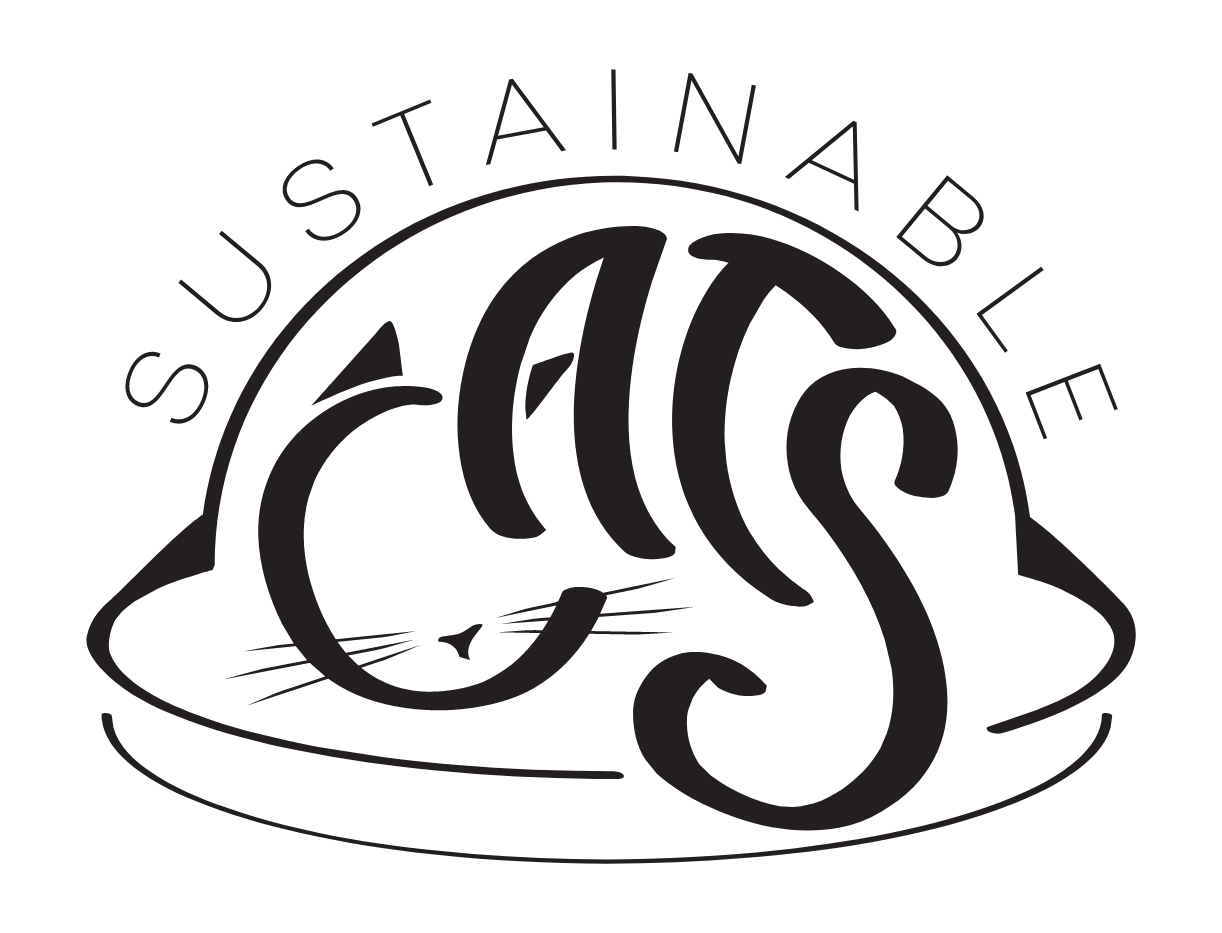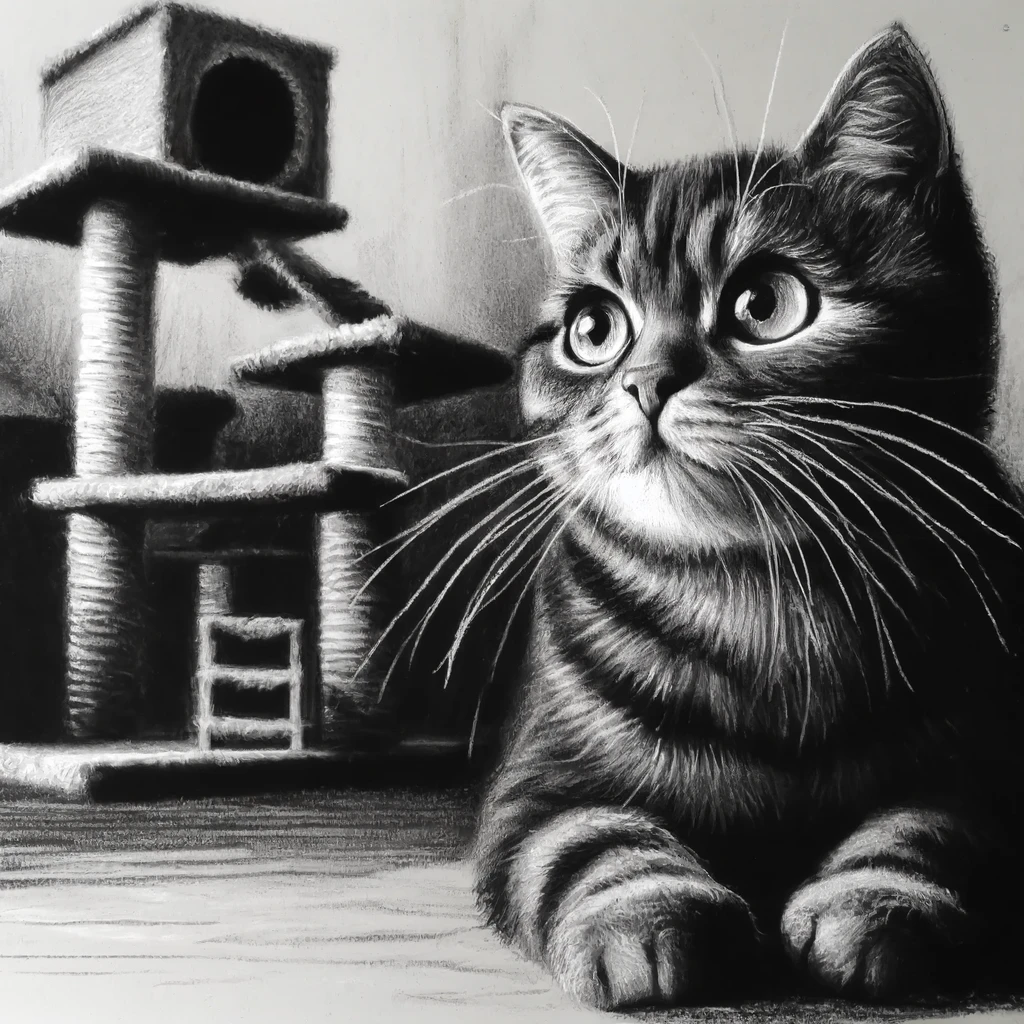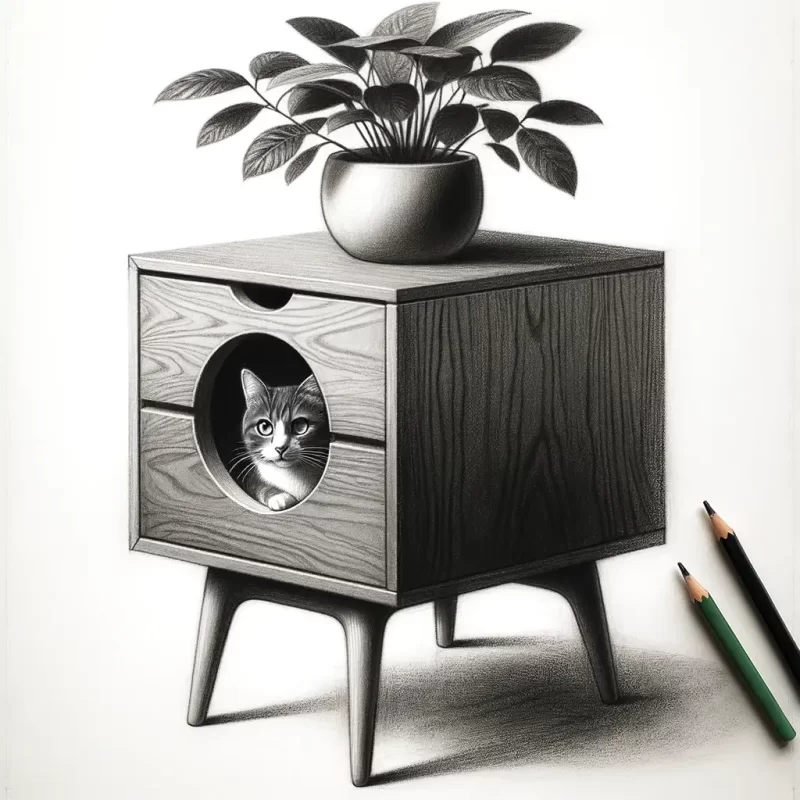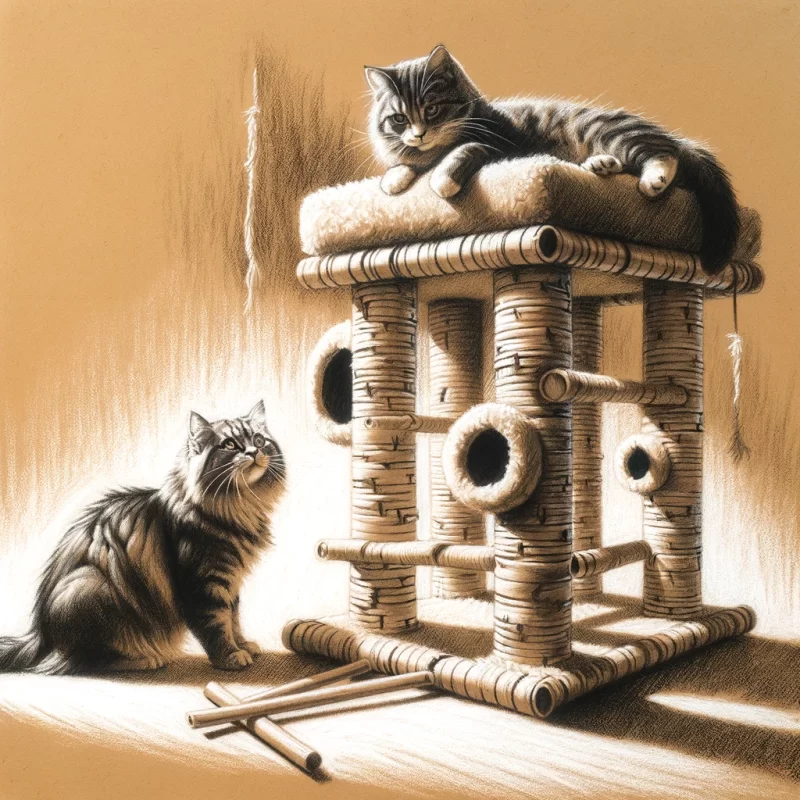This guide on green cat furniture choices will help eco-conscious cat owners pick the best sustainable cat furniture to match their homes, values, and felines’ preferences and well-being!
Over 100 million cats are estimated to be cherished pets in the United States, highlighting a significant aspect of domestic life where sustainability can play a vital role. As our collective attention turns towards reducing our environmental impact, so grows the desire for eco-friendly alternatives in all areas of our lives—including pet ownership.
Selecting cat furniture is no exception to this green revolution.
Today, feline enthusiasts are increasingly seeking cat furniture that aligns with their aesthetic preferences and environmental ethics. Sustainability has become a paramount consideration, driving the design and manufacturing of pet products toward materials and practices that minimise ecological footprints.
Deciphering Eco-Friendly Materials
When selecting cat furniture with sustainability in mind, dissecting the materials used in construction is crucial. Look for recyclable or biodegradable components such as bamboo, reclaimed wood, or FSC-certified timber, which ensure forest sustainability. Avoid items made with volatile organic compounds (VOCs), which are detrimental to feline health and the environment. Equally important is to seek out non-toxic adhesives, stains, and natural fibres like organic cotton or hemp fabrics. Such fabrics are especially preferable if they are sourced through ethical trade practices. A genuinely eco-friendly piece of cat furniture supports a healthier planet and contributes to a toxin-free habitat for your feline companion.
The Sustainability of Sourcing
Sourcing materials conscientiously is foundational to eco-friendly cat furniture—balancing cat wellness with environmental stewardship.
Globally, cat furniture crafted sustainably protects biodiversity and helps curtail deforestation, enhancing our shared global ecosystem.
Ensuring that renewable materials, like plantation-grown trees or recycled metals, advance this goal while maintaining durability. Companies genuinely invested in sustainability track their materials’ origins, ensuring they contribute positively to environmental health and resilience.
Carefully selected, ethically sourced materials do not merely evoke natural appeal—they embody a commitment to preserving habitats, showcasing a tangible contribution to conservation efforts.
Life-Cycle of Cat Furniture Materials
Understanding the life cycle of cat furniture materials is vital to gauging its environmental footprint. From extraction and manufacturing to usage and eventual disposal, each phase bears ecological integrity and sustainability implications.
Natural materials like wood, wicker, or bamboo regenerate only if sourced from managed forests or plantations. This ensures a balance between harvest and regrowth.
The manufacturing process can introduce chemicals, energy use, and waste, impacting a product’s overall eco-friendliness. Opting for manufacturers that utilise renewable energy and non-toxic adhesives mitigates these effects.
At the product’s end of life, biodegradable materials return to the earth with minimal environmental disturbance. In contrast, synthetic materials may take centuries to decompose, if at all. This distinction underscores the importance of choosing cat furniture with a biodegradable composition aligned with principles of environmental stewardship and circularity.
Hazardous Chemicals to Avoid
Volatile Organic Compounds (VOCs) are pervasive in furniture.
The production of cat furniture often involves adhesives, paints, and finishes. These can contain various chemicals that, while enhancing product durability and appearance, pollute the indoor air we share with our feline companions. Among these substances are Formaldehyde, which is frequently found in pressed wood and adhesives, and Polyurethane, a common sealant and finish that can be toxic.
Formaldehyde is a known carcinogen and irritant.
Further, be wary of Phthalates and PVC in cat furniture components—they compromise indoor air quality and human health. Phthalates, used to soften plastics, are endocrine disruptors, and PVC releases dioxins when burnt, which are serious threats to health and the environment.
Opt for natural latex instead of synthetic foams.
Choosing furniture free of known carcinogens is paramount—aiming for products with natural, untreated fabrics and wood. Check for certifications like the OEKO-TEX Standard 100 that validate safety in terms of chemical use, ensuring that substances harmful to cats are absent from the furniture you bring into your home.
Design Beyond Aesthetics
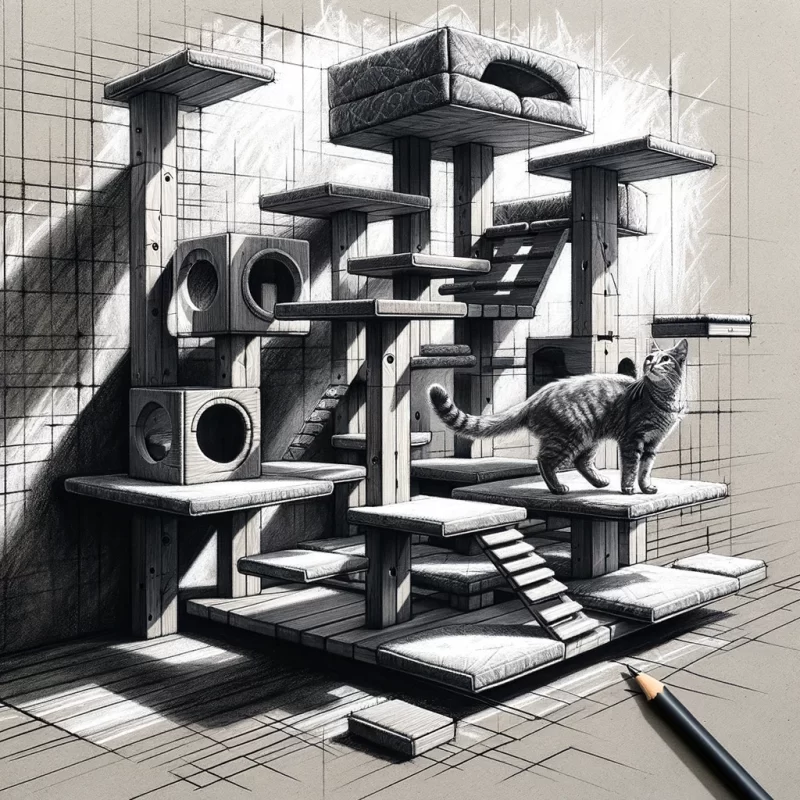
The prevailing narrative in eco-friendly cat furniture must amplify the conversation beyond visual appeal. Design integrity encompasses the harmony of form and the essence of sustainable sourcing and non-toxicity, directly correlating to the well-being of our domestic feline friends and the planet they inhabit.
Adopting a holistic approach to design emphasises the intersection between functionality, environmental stewardship, and health-centric attributes. Discerning consumers should prioritise pieces that reflect a commitment to ecological integrity while offering our cats the physical comfort and stimulation they need.
Modular Pieces for Longevity
Modular cat furniture offers remarkable adaptability and longevity. Utilising interchangeable parts enables you to refresh or augment your cat’s environment without necessitating the purchase of entirely new structures. Therefore, it extends the product’s life while minimising waste—a cardinal aspect of sustainable living. Moreover, modular configurations allow for the evolution of the furniture to suit the changing needs and preferences of your feline companion as they progress through different life stages.
Adaptability is the cornerstone of sustainability.
Certain modular systems incorporate an upcycling ethos by design. They enable cat owners to rearrange components to prevent boredom and maintain engagement, and they also allow for the replacement of specific elements rather than the entire ensemble. By selecting modular furniture, you can ensure pieces remain fresh and functional, postponing the endpoint of their product lifecycle well beyond that of traditional, static designs.
Choose longevity; invest in modularity.
In transitioning towards circular economy principles, eco-friendly modular cat furniture often incorporates materials with a lower environmental footprint. We anticipate that advancements in design will increasingly integrate bio-based or recycled materials, reflecting an entwined commitment to both the well-being of our cats and the preservation of ecosystems. These progressive modular designs promulgate the notion that stylish, engaging cat furniture can concurrently support the goal of a more sustainable future.
Repairable & Upgradable Options
Opting for cat furniture that can be mended extends its viability. Sustainable choices often include replaceable components, ensuring a longer life for the product.
Durability is key when considering eco-friendly options. Select pieces with timeless design and constructed from robust materials.
Look for manufacturers that provide separate parts or additional modules. This enables personal customisation and means that the product can evolve with your cat’s changing needs, reducing the likelihood of premature disposal due to damage or disinterest.
Choosing repairable and upgradable furniture demonstrates a commitment to reducing waste. It empowers you to seamlessly integrate new elements into the existing structure, maintaining its utility and appeal without resorting to complete replacement. This thoughtful approach aligns with the ethos of a regenerative economy, where products are designed to adapt and endure. In essence, selecting such furnishings is a testament to a philosophy of ‘less is more’ fostering sustainable living practices.
Ethical Production Unmasked
To discern truly sustainable cat furniture, one must scrutinise the genesis of each piece. This requires examining the supply chain for ethical labour practices, renewable resources, and energy-efficient manufacturing processes. Furthermore, brands’ commitment to transparency is critical, as it affirms their accountability and dedication to sustainability throughout the production cycle.
Seeking certifications from reputable eco-labels can help identify ethically produced furnishings. These endorsements guarantee that stringent environmental and social standards are upheld from raw material extraction to the final product, thus ensuring that your choice actively contributes to environmental stewardship and ethical labour practices.
Transparency in the Supply Chain
Transparency in sourcing materials is pivotal for eco-conscious cat furniture. Elevated scrutiny yields insight into the sustainability and ethics of creating products that align with the pet’s comfort and the planet’s welfare.
A manufacturer’s openness regarding suppliers and production methods indicates its commitment to environmental stewardship. It reflects the trust it wishes to build with consumers who prioritise green purchasing decisions, ensuring its offerings are both benign and beneficial.
When companies provide detailed information about the origins of their materials, they empower consumers with the knowledge to make informed choices. This transparency extends to the labour used in crafting the furniture, defending against exploitation and fostering fair trade practices.
Genuine sustainability requires rigorous verification of supply chains to minimise carbon footprints and waste. This necessitates partnering with suppliers who adopt responsible practices and are willing to undergo third-party audits to authenticate their claims.
The cornerstone of true eco-friendly cat furniture lies in the ability to trace each component back to its source. Only with this level of transparency can the sustainable claims of any brand be fully credentialed and trusted by conscientious consumers.
Fair Labor Practices and Artisanship
Sustainable cat furniture must be crafted under ethical working conditions that respect artisans and the environment. This ensures integrity and quality throughout the production process.
Fair labour practices are non-negotiable for genuine sustainability in cat furniture production. They provide a moral compass for manufacturing.
While selecting cat furniture, look for brands that showcase their commitment to artisanal craftsmanship. Such companies typically employ skilled artisans who contribute to the creation of each piece, often using traditional techniques that are environmentally sensitive and culturally significant.
Producing eco-friendly cat furniture should be something other than a race to the bottom in cost or humanity. It requires a steadfast commitment to fair wages, safe working conditions, and respect for the time-honoured skills of the artisans. With responsible stewardship, we can achieve an equilibrium where superior craftsmanship coexists with sustainable practices to produce objects of beauty that both the cat and the owner can cherish.
End-of-Life Matters
When considering sustainability, the disposal or reincarnation of used items is paramount. An ideal piece of eco-friendly cat furniture should be designed with its eventual departure in mind, focusing on biodegradability or recyclability. Select items that can re-enter the life cycle without leaving detrimental footprints on the Earth’s ecosystems.
The green journey of cat furniture transcends its functional lifespan—consideration must be given to what happens post-use. Seek out products with established take-back programs or recycling partnerships, ensuring the materials don’t just end up in a landfill. As caretakers of the planet, it is our duty to close the loop and select furniture that aligns with the principles of a circular economy, thereby reducing the overall environmental impact.
Biodegradability and Recycling
Choosing eco-friendly cat furniture requires considering materials that are gentle on the environment in use and disposal.
- Search for biodegradable materials like bamboo, untreated wood, or natural fibres that decompose naturally.
- I prefer items that are free of toxic chemicals and synthetic substances.
- Select furniture crafted with recyclable components such as metals, glass, or plastics.
- Prioritise manufacturers who offer take-back programs or partner with recycling facilities.
Products crafted from sustainable materials can often be returned to the earth or repurposed.
Assure long-term sustainability by selecting cat furniture that supports the ethos of the circular economy, ultimately leaving a minimal ecological footprint.
Donation & Disposal with a Conscience
Sustainable pet ownership extends to how we dispose of or donate cat furniture that no longer serves our feline friends.
- Donate gently used cat furniture to local shelters or rescue organisations.
- Upcycle components into new, functional pieces for home or garden use.
- Repurpose textiles or cushioning into bedding for smaller animals.
- Contact local waste management about recycling options for specific materials.
- List items on online platforms dedicated to free exchanges or second-hand sales.
Disposal should be a last resort—examine donation or upcycling opportunities first.
Compassion towards the environment is expressed through thoughtful disposal, accentuating our commitment to the planet.
What are some eco-friendly materials used in green cat furniture?
Eco-friendly materials are an essential component of green cat furniture, as they minimise the environmental impact of pet ownership. Here are some commonly used eco-friendly materials in green cat furniture:
- Bamboo is a fast-growing, renewable resource that is sturdy and durable. It is often used to frame cat trees and scratching posts.
- Recycled cardboard: Cardboard is famous for cat furniture, such as scratchers and playhouses. When made from recycled materials, it helps reduce waste and promotes a circular economy.
- Hemp: Hemp is a solid and sustainable natural fibre. It makes cat beds and scratched surfaces, offering a durable, eco-friendly option.
- Sisal: Sisal is a natural fibre extracted from the sisal plant. It is commonly used for the scratching posts of cat trees due to its durability and ability to withstand scratching.
- Recycled plastic: Cat furniture made from recycled plastic helps reduce the demand for virgin plastic and prevents plastic waste from entering landfills or the ocean. It can be transformed into various shapes, including litter boxes and play tunnels.
- Organic cotton: Organic cotton is grown without harmful pesticides or fertilisers. It is a soft, sustainable material often used for cat beds and plush toys.
- Natural wood: Solid wood from sustainably managed forests is a popular eco-friendly choice for cat furniture. It is sturdy, long-lasting, and adds a touch of natural beauty to the furniture pieces. Opting for cat furniture made from these eco-friendly materials can provide your feline friend with a comfortable and sustainable environment while reducing your ecological footprint.
How do green cat furniture choices compare to traditional options in terms of durability?
Several factors come into play when considering the durability of green cat furniture compared to traditional options. While traditional cat furniture is often made from wood, carpet, and synthetic fabrics, green cat furniture utilises more sustainable and eco-friendly materials such as bamboo, recycled plastics, and natural fibres.
While both traditional and green cat furniture can be durable, there are some key differences to consider. Green cat furniture often incorporates materials more resistant to wear and tear, such as bamboo, which is known for its strength and durability. Additionally, many green cat furniture options use high-quality, natural fibres that are less likely to fray or become damaged over time.
Furthermore, green cat furniture manufacturers often prioritise using non-toxic adhesives and finishes, ensuring the furniture is safe for both cats and the environment. This focus on eco-friendly materials and production processes can contribute to green cat furniture’s overall longevity and durability.
It is important to note that the durability of any cat furniture ultimately depends on factors such as the individual cat’s behaviour, usage patterns, and overall maintenance. Regular cleaning and proper care can extend the lifespan of both traditional and green cat furniture options.
In summary, green cat furniture choices offer comparable or even improved durability compared to traditional options. Using sustainable materials, non-toxic finishes, and high-quality construction methods contributes to green cat furniture’s longevity and durability. By choosing green cat furniture, sustainable cat owners can provide their furry companions with durable and environmentally friendly options.
Can green cat furniture be customised to fit specific design preferences?
Green cat furniture can be customised to fit specific design preferences. As a sustainable cat owner, you can create a unique and personalised environment for your furry friend while maintaining your commitment to eco-friendly choices.
One way to customise green cat furniture is by choosing the materials used in its construction. Look for options from sustainable and renewable resources such as bamboo, reclaimed wood, or recycled materials. These materials minimise the environmental impact and add a touch of natural beauty to the furniture.
Additionally, many manufacturers offer a range of colour and pattern options for the upholstery or accents of green cat furniture. This allows you to match the furniture to your existing home decor or create a design that reflects your style. Whether you prefer bold and vibrant colours or subtle and earthy tones, customisation options are available to suit your preferences.
Furthermore, green cat furniture can also be customised in terms of functionality. Some designs offer modular components that can be rearranged and adapted to meet your cat’s specific needs. For example, you may add scratching posts, perches, or hiding spots to create an inviting and interactive space for your feline companion.
When considering customisation options for green cat furniture, it is essential to prioritise sustainability and durability. Look for furniture built to last, using non-toxic and pet-friendly finishes. This ensures that your customisation choices align with your commitment to a sustainable and safe environment for your cat.
In summary, green cat furniture can be customised to fit specific design preferences by selecting sustainable materials, choosing colour and pattern options, and adapting the functionality to suit your cat’s needs. With these customisation options, you can create a sustainable and personalised space you and your cat will love.
Are there any specific certifications or labels to look for when shopping for environmentally friendly cat furniture?
It would be best to look for several certifications and labels when shopping for environmentally friendly cat furniture. These certifications and labels ensure that the product meets specific environmental standards. Here are a few examples:
- Forest Stewardship Council (FSC) Certification: The FSC certification indicates that the wood used in the cat furniture has been sourced from responsibly managed forests. This certification ensures that the wood has been harvested in an environmentally friendly and socially responsible manner.
- Greenguard Certification: Greenguard certification ensures that the cat furniture has been tested for low chemical emissions. It guarantees the product meets strict indoor air quality standards, making it safe for your cat and the environment.
- Cradle to Cradle (C2C) Certification: The C2C certification focuses on the product’s lifecycle. It evaluates materials used, manufacturing processes, and the product’s recycling or composting ability. Look for cat furniture with a C2C certification to ensure its sustainability.
- Global Organic Textile Standard (GOTS): GOTS certification applies to cat furniture made from organic textiles. Look for this label if you prefer furniture made from natural and organic materials free from harmful chemicals and pesticides.
- USDA Certified Organic: This label is important if you purchase cat furniture made from organic materials, such as catnip or cushions. The USDA organic certification ensures that these materials have been produced without synthetic fertilisers, pesticides, or genetically modified organisms (GMOs).
- Energy Star Certification: While not specific to cat furniture, the Energy Star certification is an important label to consider when shopping for electronic cat furniture like heated beds or interactive toys. This label indicates that the product meets strict energy efficiency guidelines, helping you reduce your environmental impact. By checking for these certifications and labels, you can confidently choose environmentally friendly cat furniture that aligns with your sustainability values.
What are some popular styles of green cat furniture available on the market?
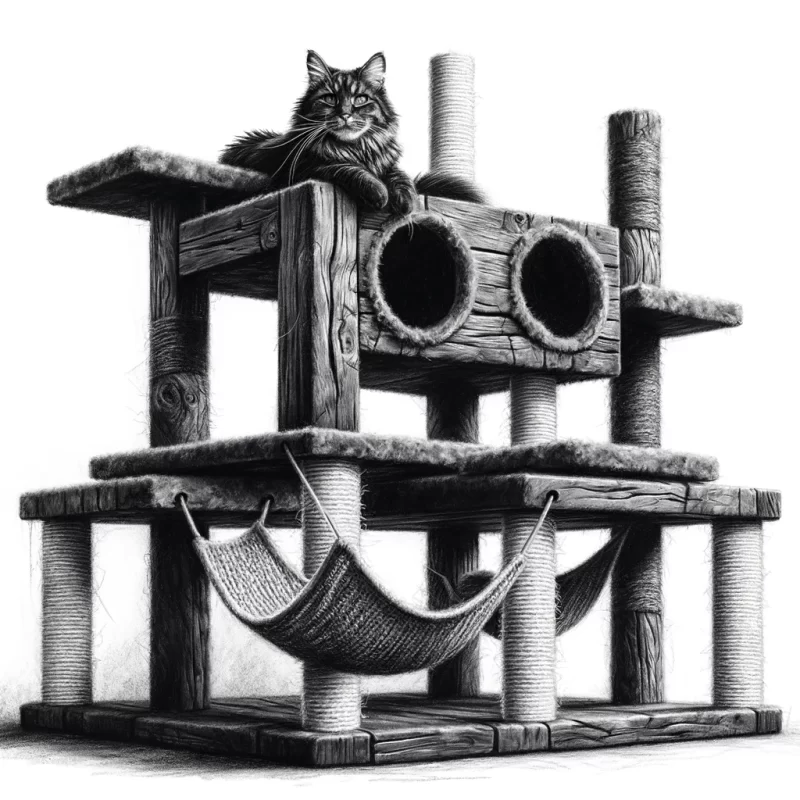
Some popular styles of green cat furniture available on the market include:
- Eco-friendly scratching posts: These are made from sustainable materials such as natural sisal or recycled cardboard. They provide a safe and environmentally friendly alternative to traditional scratching posts while satisfying your cat’s natural scratching instincts.
- Natural wood climbing trees: These cat trees are constructed using sustainably sourced wood, such as bamboo or reclaimed timber. They provide your cat with a sturdy and durable climbing structure while adding a touch of natural beauty to your home.
- Organic cat beds are made from organic materials such as cotton, hemp, or bamboo. They are free from harmful chemicals and provide a cosy and comfortable resting place for your cat while minimising your environmental footprint.
- Natural fibre toys: Toys made from natural fibres like hemp or organic cotton are a sustainable choice for entertaining your cat. These toys are durable, non-toxic, and biodegradable, ensuring less environmental impact than plastic toys.
- Energy-efficient cat water fountains: These innovative fountains are designed to use less electricity while providing a continuous supply of fresh, filtered water for your cat. They help conserve energy and promote hydration for your feline friend. By choosing cat furniture with these eco-friendly features, you can create a sustainable and responsible environment for your cat while contributing to a greener planet.
Are there any specific factors to consider when choosing green cat furniture for a multi-cat household?
When choosing green cat furniture for a multi-cat household, there are several key factors to consider.
First and foremost, selecting furniture made from sustainable materials is important. Look for options manufactured using recycled or upcycled materials like cardboard, reclaimed wood, or eco-friendly fibres. Additionally, consider furniture free from harmful chemicals and toxins, ensuring the health and safety of your cats.
Another critical factor to consider is the durability and sturdiness of the cat furniture. In a multi-cat household, the furniture will likely experience more wear and tear, so choosing options built to withstand the active play and climbing of multiple cats is crucial. Look for furniture with solid construction and reinforced scratching posts and platforms.
Size and functionality are also important considerations. Multi-cat households often require larger pieces of furniture to simultaneously accommodate the needs of multiple cats. Ensure that the cat furniture has enough space for each cat to comfortably rest, play, and observe their surroundings. Look for furniture that includes various features such as scratching posts, perches, hiding spots, and interactive toys to keep your cats engaged and entertained.
Furthermore, the ease of cleaning and maintenance should be considered. Opt for cat furniture that is easy to wipe or vacuum clean to maintain a fresh and hygienic environment for your cats. Removable and washable covers or cushions can also be beneficial for keeping the furniture clean and odour-free.
Finally, remember to take your cats’ individual preferences and needs into account. Some cats may prefer vertical structures for climbing and observing, while others may enjoy cozy hideaways. Consider your cats’ unique personalities and behaviours when selecting green cat furniture to ensure it suits their needs and preferences.
By considering these factors when choosing green cat furniture for a multi-cat household, you can create a sustainable and enriching environment that promotes the well-being and happiness of your feline companions.
How does the price of green cat furniture compare to traditional options?
There are a few key factors to consider when considering the price of green cat furniture compared to traditional options.
Firstly, it’s important to note that green cat furniture is typically made from environmentally friendly and sustainable materials. These materials may include natural or recycled organic cotton, bamboo, or reclaimed wood. Using these materials can increase the production costs of green cat furniture compared to traditional options, as they are often more expensive to source and process.
The manufacturing processes involved in creating green cat furniture may also contribute to a higher price point. Manufacturers of green cat furniture often prioritise sustainable practices, which may require additional investments in eco-friendly production methods, such as using non-toxic adhesives or low VOC (Volatile Organic Compounds) finishes. These considerations can result in higher production costs, which can be reflected in the price of the final product.
However, it’s essential to consider the long-term benefits of investing in green cat furniture. While the initial cost may be higher than traditional options, green cat furniture is often designed to be more durable and long-lasting. This means you may need to replace or repair the furniture less frequently, ultimately saving you money in the long run.
Furthermore, green cat furniture can create a healthier living environment for your cat and your family. By opting for furniture made from natural and non-toxic materials, you can minimise the risk of your cat being exposed to harmful chemicals or allergens that may be present in traditional options.
Due to sustainable materials and eco-friendly manufacturing processes, green cat furniture may be more expensive than traditional options. However, the long-term benefits, such as durability, reduced health risks, and environmental sustainability, make it a worthwhile investment for conscientious cat owners.
Are there any specific maintenance or cleaning requirements for green cat furniture?
Maintaining and cleaning green cat furniture is essential to ensure longevity and hygienic conditions for your feline friend. Here are some specific maintenance and cleaning requirements to keep in mind:
Regular Inspection:
- Conduct routine inspections to identify wear and tear, loose parts, or damage to the green cat furniture. This will help address any issues before they worsen.
Cleaning Schedule:
- Establish a regular cleaning schedule to keep the green cat furniture in top condition. This can vary based on the usage and material, but a general recommendation is to clean it at least once a month.
Dust and Debris Removal:
- Start by removing any visible dust, hair, or debris from the surface of the green cat furniture. You can gently remove these particles by using a soft brush, a lint roller, or a vacuum cleaner with a brush attachment.
Spot Cleaning:
- If there are any localised stains or spills on the green cat furniture, it’s best to spot clean them immediately. Use a mild, pet-friendly cleaner and a soft cloth to blot the affected area gently. Avoid using harsh chemicals or abrasive cleaners that can damage the material.
Deep Cleaning:
- Depending on the material of the green cat furniture, you may need to perform a deep cleaning occasionally. Follow the manufacturer’s instructions or consult with a professional to determine the appropriate method for deep cleaning without causing any damage.
Odor Control:
- To maintain a fresh-smelling environment, consider using odour neutralisers or pet-friendly sprays designed explicitly for cat furniture. These products can help eliminate any unpleasant odours that may accumulate over time.
Scratching Post Maintenance:
- If your green cat furniture includes a scratching post, it’s important to trim and maintain it regularly. This will encourage your cat to use and prevent it from becoming frayed or worn out.
Proper Storage:
- Suppose you need to temporarily store the green cat furniture and clean and dry it thoroughly before storing it. Please keep it in a cool, dry place away from direct sunlight and moisture to prevent mould or mildew growth.
Following these maintenance and cleaning requirements ensures that your green cat furniture remains in excellent condition and provides a safe and comfortable space for your beloved feline companion.
What are some benefits of choosing green cat furniture for both cats and the environment?
Green cat furniture offers numerous benefits for both cats and the environment. One of the key advantages is its sustainability. You consciously choose to minimise your ecological footprint by opting for green cat furniture.
These eco-friendly products are made from sustainable materials that are either renewable or recycled. This helps reduce the demand for virgin resources, such as wood or plastics, often used in traditional cat furniture. Using renewable or recycled materials, green cat furniture helps conserve natural resources and reduce the amount of waste that ends up in landfills.
Moreover, green cat furniture is often manufactured with non-toxic and low VOC (volatile organic compound) materials. This is particularly important for your feline friend’s health and well-being. Cats are known for their curious nature and propensity to chew or scratch on furniture. By choosing green cat furniture, you can minimise their exposure to potentially harmful chemicals and ensure a safer living environment for them.
In addition to being environmentally friendly, green cat furniture is designed to provide maximum comfort and enrichment for your pets. These products are often thoughtfully constructed to cater to a cat’s instincts and behaviours. They may feature scratching posts, climbing structures, cosy beds, and interactive toys. By selecting green cat furniture, you invest in items that prioritise your cat’s physical and mental stimulation, leading to happier and healthier feline companions.
Furthermore, supporting companies that produce green cat furniture promotes sustainability within the pet industry. By choosing these environmentally conscious products, you encourage manufacturers to continue developing and innovating sustainable pet solutions. This contributes to the broader movement towards a more eco-friendly and responsible pet ownership culture.
In summary, green cat furniture benefits cats and the environment in multiple ways. It reduces environmental impact through sustainable materials, promotes healthier living for cats by minimising exposure to harmful chemicals, and enhances their overall well-being through thoughtful design and enrichment. By choosing green cat furniture, you positively contribute towards a more sustainable and eco-friendly lifestyle for your beloved feline and the planet.
Are there any potential drawbacks or limitations when choosing green cat furniture?
While green cat furniture choices offer many benefits, there are potential drawbacks and limitations. It is essential to be aware of these factors before making a decision.
One possible drawback is the initial cost. Green cat furniture, especially those made from eco-friendly materials, can be more expensive than traditional options. This may require a larger investment upfront. However, it is essential to remember that in the long run, the durability and sustainability of these products can outweigh the initial cost.
Another limitation to consider is the availability of options. Green cat furniture is still a niche market, and there may be fewer choices than conventional cat furniture. Finding specific styles or designs might be more challenging. However, with the growing popularity of eco-friendly products, the market is expanding, and more options are becoming available.
Furthermore, it is crucial to acknowledge that green cat furniture may not suit every cat’s preferences or needs. Cats are unique individuals with varying preferences for scratching surfaces, resting areas, and play structures. Some cats may not find eco-friendly materials as appealing as other textures or materials commonly found in traditional cat furniture. Therefore, observing your cat’s behaviour and providing alternative options if needed is essential.
Lastly, maintaining green cat furniture can require extra care and attention. Some eco-friendly materials may be more sensitive to moisture, scratching, or wear and tear than conventional materials. Regular cleaning and maintenance are necessary to ensure the longevity of the furniture and prevent any potential damage.
Overall, while there are some drawbacks and limitations to consider, the benefits of green cat furniture, such as reduced environmental impact and better indoor air quality, often outweigh these concerns. Informed decision-making based on your cat’s needs and budget is critical to finding the most suitable and sustainable furniture options for your furry friend.
